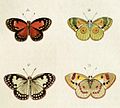
Pontia daplidice, the Bath white, is a small butterfly of the family Pieridae, the yellows and whites, which occurs in the Palearctic region. It is common in central and southern Europe, migrating northwards every summer, often reaching southern Scandinavia and sometimes southern England.
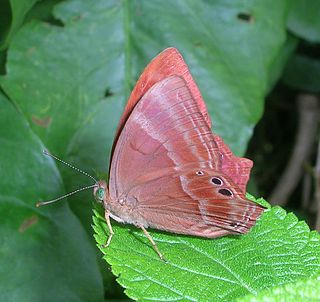
Abisara echerius, the plum Judy, is a small but striking butterfly found in Asia belonging to the Punches and Judies family (Riodinidae). It is difficult to distinguish it from Abisara bifasciata.

Eurema hecabe, the common grass yellow, is a small pierid butterfly species found in Asia, Africa and Australia. They are found flying close to the ground and are found in open grass and scrub habitats. It is simply known as "the grass yellow" in parts of its range; the general term otherwise refers to the entire genus Eurema.
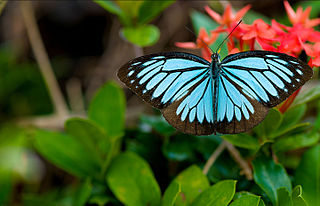
Pareronia valeria, the common wanderer or Malayan wanderer, is a medium-sized butterfly of the family Pieridae, that is, the yellows and whites, and is found in India and Southeast Asia. The butterfly found in India is sometimes considered as a separate species, Pareronia hippia.

Belenois aurota, the pioneer or pioneer white or caper white, is a small to medium-sized butterfly of the family Pieridae, that is, the yellows and whites, which is found in South Asia and Africa. In Africa, it is also known as the brown-veined white, and is well known during summer and autumn when large numbers migrate north-east over the interior.
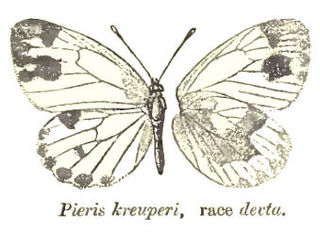
Pieris krueperi devta, the green-banded white, is a small butterfly of the family Pieridae, that is, the yellows and whites. It is found in India and Pakistan. It is a subspecies of Krueper's small white.

Pontia chloridice, the lesser Bath white, is a small butterfly of the family Pieridae, that is, the yellows and whites. The species is found in steppe zone of Ukraine, Moldova and Russia; east to Transbaikalia, Mongolia, Korea; south to Balkan Peninsula, Turkey, Transcaucasia, Greater Caucasus, Iran, Northern Pakistan, Central Asia, Kazakhstan.

Colotis phisadia, the blue-spotted Arab, is a small butterfly of the family Pieridae, that is, the yellows and whites, which is found in Mauritania, Senegal, Mali, Nigeria, Niger, Chad, Sudan, Ethiopia, Kenya, Kuwait, Uganda, Arabia, the Near East and India.

Colotis vestalis, the white Arab, is a small butterfly of the family Pieridae, that is, the yellows and whites, which is found in India, Pakistan, Iran, Somalia, Ethiopia, Sudan, Kenya and Tanzania. It has a wingspan of 4–5 cm.

Colotis fausta, the large salmon Arab, is a small butterfly of the family Pieridae, that is, the yellows and whites, which is found in Israel, Syria, Turkey, Iran, Afghanistan, Turkmenistan, India, Arabia, Chad, Somalia and United Arab Emirates.

Colotis etrida, the little orange tip, is a species of butterfly in the family Pieridae. It is native to India, Sri Lanka and Pakistan.

Colotis danae, the crimson tip or scarlet tip, is a small butterfly of the family Pieridae, that is, the yellows and whites. It is found in Asia and Africa.

Pontia callidice, the lofty Bath white or peak white, is a small butterfly of the yellows and whites family (Pieridae), which occurs in the Palearctic realm.
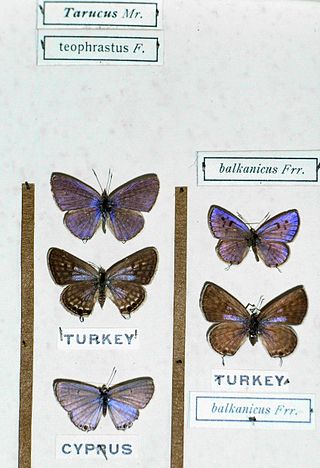
Tarucus theophrastus, the common tiger blue, pointed Pierrot or African Pierrot, is a small butterfly found in the Old World tropics. It belongs to the lycaenids or blues family.

Orthomiella pontis, the straightwing blue, is a small butterfly found in India that belongs to the lycaenids or blues family.

Jamides bochus, the dark cerulean, is a small butterfly found in Indomalayan realm that belongs to the lycaenids or blues family. The species was first described by Caspar Stoll in 1782.

Anthene emolus, the ciliate blue, is a small butterfly found in India and southeast Asia that belongs to the lycaenids or blues family. The species was first described by Jean-Baptiste Godart in 1823.
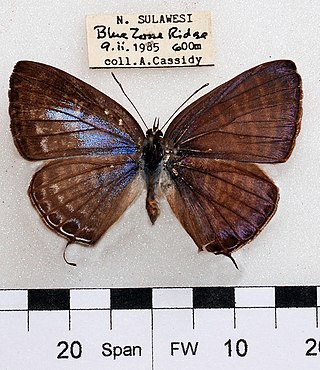
Nacaduba pactolus, the large four-line blue, is a species of lycaenid butterfly found in Indomalayan realm.
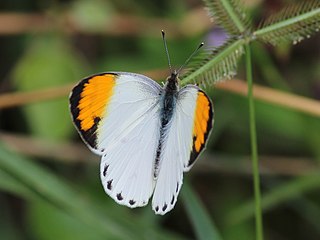
Colotis aurora, the sulphur orange tip or plain orange-tip, is a butterfly in the family Pieridae. It is found in Asia and Africa. The nominate subspecies, Colotis aurora aurora is found in India and Sri Lanka. The other subspecies, Colotis aurora evarne is found in Mauritania, Senegal, the Gambia, Mali, Burkina Faso, Ghana, Benin, Nigeria, Chad, Sudan, Ethiopia, Uganda, Kenya, Rwanda, Tanzania, the Democratic Republic of the Congo, Somalia, and southern Arabia.

Pareronia hippia, the common wanderer or Indian wanderer, is a medium-sized butterfly of the family Pieridae, that is, the yellows and whites. It is found in India. Some authors consider this as a subspecies of Pareronia valeria.








